You’ll need just three ingredients for an effective neem oil aphid spray: 100% pure cold-pressed neem oil, gentle dish soap as an emulsifier, and purified water. Mix 2 tablespoons of neem oil with 1 gallon of water and 2 teaspoons of dish soap. The neem oil contains azadirachtin, which disrupts aphid reproductive cycles while also repelling them. This combination creates a potent solution that targets multiple aphid species and addresses secondary fungal infections that often accompany infestations.
What Is Neem Oil and Why It Works Against Aphids
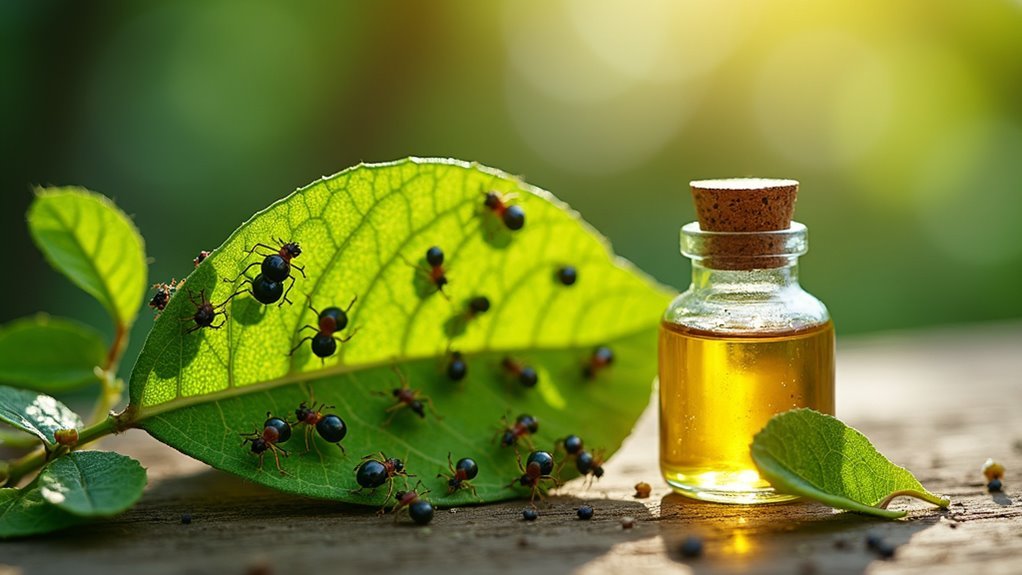
When you’re battling aphids in your garden, neem oil stands out as one of nature’s most effective weapons. Derived from neem tree seeds (Azadirachta indica), this natural solution contains azadirachtin, a powerful compound that disrupts aphid reproductive cycles.
Unlike harsh chemical pesticides, neem oil works as both an insecticide and repellent, preventing aphids from feeding and ultimately starving them.
What makes neem oil particularly valuable is its versatility—it’s effective against multiple aphid species while simultaneously addressing secondary problems.
You’ll find it doesn’t just control pests; it also tackles fungal infections that often accompany aphid infestations. This dual-action approach makes neem oil spray an efficient, eco-friendly choice for maintaining healthy plants without compromising your garden’s natural ecosystem.
Essential Ingredients for Homemade Neem Oil Aphid Spray
Three essential ingredients form the foundation of an effective homemade neem oil aphid spray that’ll protect your plants naturally.
Three simple ingredients create a powerful natural defense against aphids while keeping your garden chemical-free and safe.
You’ll need 100% pure cold-pressed neem oil containing azadirachtin, which disrupts aphids’ reproductive cycles. For one gallon of spray, combine 2 tablespoons of this potent oil with purified water and gentle dish soap.
The dish soap serves as a vital emulsifier, breaking down the neem oil so it mixes properly with water. Without this component, your aphid spray won’t work effectively since oil and water don’t naturally combine.
- 2 tablespoons 100% pure cold-pressed neem oil
- 1 gallon purified water
- 2 teaspoons gentle dish soap
- Fresh mixture (use within 8 hours)
Remember to prepare small batches and use them quickly to maintain maximum potency against aphid infestations.
Complete DIY Neem Oil Spray Recipe for Aphid Control
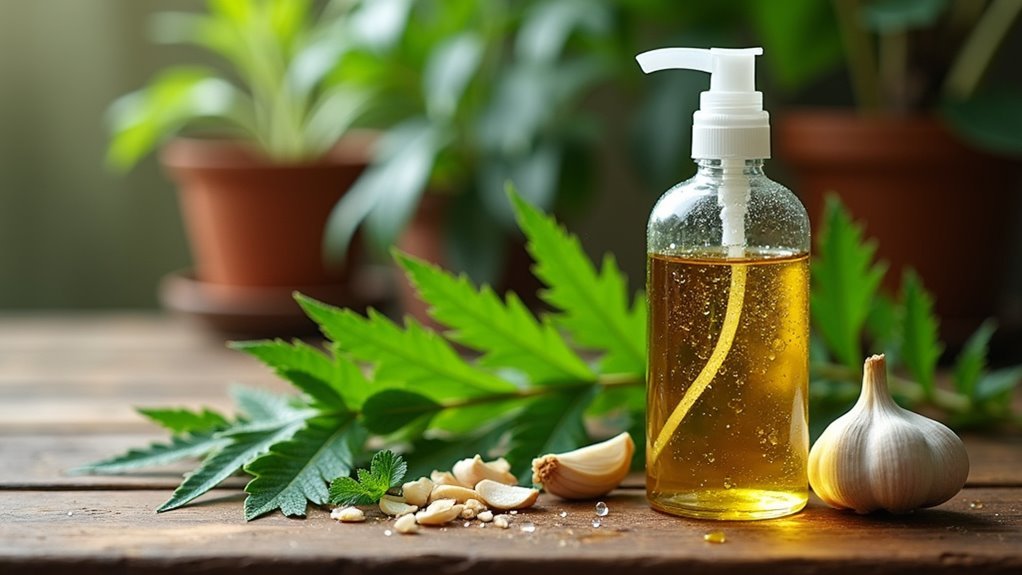
Creating your own powerful neem oil aphid spray requires following precise measurements and timing to achieve maximum pest control results.
You’ll need 2 tablespoons of 100% pure, cold-pressed neem oil mixed with 1 gallon of water and 2 teaspoons of gentle dish soap. The soap guarantees proper emulsification of the oil. Cold-pressed neem oil contains azadirachtin, which disrupts aphid reproductive cycles for effective aphid control.
Prepare small batches since neem oil degrades rapidly in water—use within 8 hours for peak potency.
Before full application, test on a single leaf to check for adverse plant reactions. Apply every 7 days for persistent infestations or every 3-4 days for severe cases, thoroughly coating both leaf tops and undersides.
Step-by-Step Mixing Instructions for Maximum Effectiveness
Five essential steps guarantee your neem oil mixture achieves maximum aphid-killing potential when you follow proper sequencing and technique.
Start by combining dish soap with purified water in your spray bottle, creating the emulsifying base that’ll help neem oil distribute evenly throughout the solution.
Create a stable emulsifying foundation by mixing soap with water first, ensuring your neem oil disperses uniformly for optimal pest control effectiveness.
Next, add your neem oil and shake vigorously to confirm complete integration.
- Mix 2 tablespoons of 100% pure neem oil with 1 gallon of purified water
- Add 2 teaspoons of gentle dish soap for proper emulsification
- Always combine soap and water before introducing neem oil
- Shake thoroughly before each application to maintain mixture consistency
You’ll need to spray your plants within 8 hours of mixing since neem oil degrades rapidly in water, losing its aphid-fighting effectiveness over time.
Proper Application Techniques for Aphid-Infested Plants
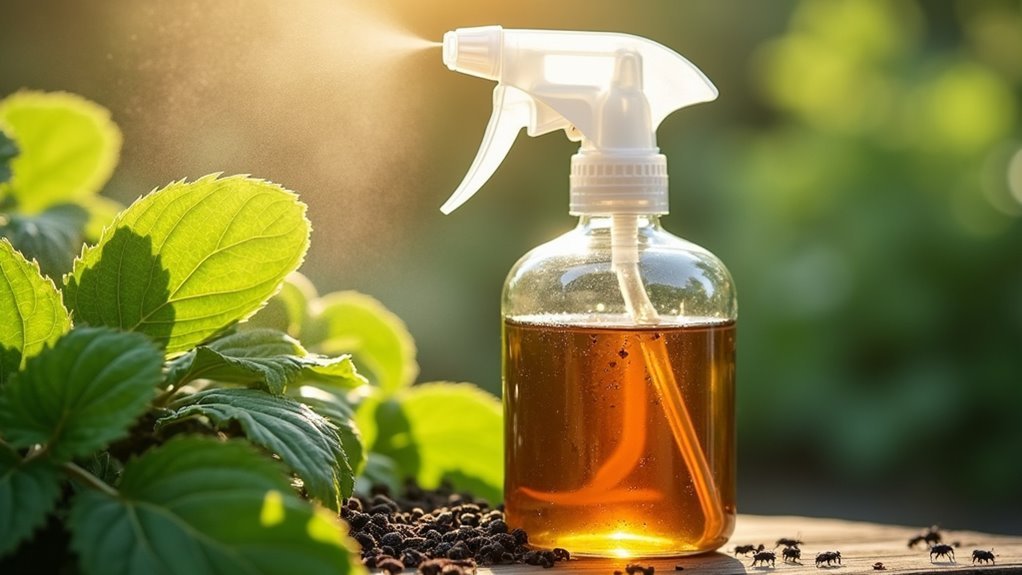
Timing your neem oil application correctly makes the difference between successful aphid control and potential plant damage.
Apply your aphid spray during morning or evening hours to prevent leaf burn from direct sunlight. Use a pump sprayer set to high pressure for effective aphid removal and thorough coverage.
Focus your application on leaf undersides where aphids typically gather. Don’t forget to saturate the plant’s base to deter protective ants that shield aphid colonies.
Verify you’re coating both tops and undersides of all leaves for complete treatment.
Your neem oil treatment requires patience—results won’t appear immediately. Reapply every seven days until you notice decreased pest populations, as consistent applications are key to breaking aphid reproduction cycles.
Best Spraying Equipment for Neem Oil Distribution
Success with neem oil aphid control depends heavily on choosing the right spraying equipment for ideal distribution. You’ll achieve better pest control results when you select tools that deliver consistent, fine coverage across your plants.
- Pump sprayers deliver high-pressure spray that effectively dislodges aphids while guaranteeing thorough coverage of all plant surfaces.
- Hair misters create finer mist distribution compared to standard bottles, preventing over-saturation of leaves during application.
- Easy-mixing spray bottles allow proper emulsification of neem oil with water and dish soap for maximum effectiveness.
- Fine misting equipment provides even coverage since neem oil’s biodegradable nature requires proper drying to maintain potency.
Always shake your equipment thoroughly before each use to guarantee neem oil and emulsifiers mix completely.
When you spray the plant evenly, you’ll maximize aphid elimination while protecting beneficial insects.
Timing and Frequency for Optimal Aphid Treatment
You’ll achieve the best results against aphids when you time your neem oil applications strategically and maintain consistent treatment schedules.
Early detection through regular plant monitoring allows you to catch infestations before they become severe, while proper timing of sprays maximizes effectiveness and prevents plant damage.
Understanding how often to apply treatments guarantees you disrupt the aphid life cycle without overusing the product.
Early Detection Importance
Before aphids establish thriving colonies that can devastate your plants, regular monitoring becomes your most powerful defense strategy.
Early detection allows you to intervene before populations escalate and cause significant damage to your garden. You’ll want to inspect your plants consistently, looking for telltale signs that indicate trouble’s brewing.
- Curled or distorted leaves – Often the first visible sign of aphid feeding damage
- Sticky honeydew residue – A clear indicator of active aphid populations nearby
- Visible colonies on leaf undersides – Check these hidden areas where aphids typically gather
- Yellowing or stunted growth – Advanced symptoms requiring immediate attention
Using neem oil becomes most effective when you catch infestations early, allowing you to control populations before they become overwhelming problems.
Application Frequency Guidelines
Once you’ve spotted aphids on your plants, timing becomes everything for successful neem oil treatment. Your application frequency directly impacts how quickly you’ll eliminate these destructive pests.
For acute infestations, apply neem oil spray every three to four days until aphids disappear completely. Don’t expect instant results—it takes two days or more to see noticeable effects. Prevention requires less frequent applications: spray every 7-14 days to keep aphids away.
| Infestation Level | Application Frequency | Expected Results | Your Action |
|---|---|---|---|
| Severe/Acute | Every 3-4 days | 2+ days to show | Stay consistent |
| Moderate | Twice weekly | Gradual reduction | Monitor progress |
| Mild | Weekly | Steady improvement | Continue routine |
| Prevention | Every 7-14 days | No infestations | Maintain schedule |
Best Spraying Times
Two critical windows exist for applying neem oil spray: early morning and late evening.
These best spraying times protect your plants from leaf burn caused by direct sunlight and heat. You’ll achieve maximum effectiveness by timing your applications strategically.
Consider these essential timing factors:
- Early morning (6-8 AM): Cooler temperatures and minimal sun exposure reduce stress on treated plants.
- Late evening (after 6 PM): Allows neem oil to work overnight without UV degradation.
- Avoid midday applications: Direct sunlight can cause phytotoxicity and reduce neem oil effectiveness.
- Weather considerations: Don’t spray before rain, which washes away the protective coating.
Remember that neem oil degrades quickly in water, so you must apply your mixed solution within 8 hours for ideal results.
Coverage Areas: Targeting Aphid Hideouts on Plants
While aphids might seem easy to spot, they’re masters at hiding in the most protected areas of your plants. You’ll need to be thorough when applying neem oil to effectively eliminate these pests.
Focus on spraying both leaf surfaces, especially the undersides where aphids cluster away from predators. Target stems and new growth areas since these tender spots attract feeding aphids.
Pay close attention to flower buds and developing fruits – prime real estate for infestations that can devastate plant development.
Don’t overlook leaf axils and the plant’s base, where tight spaces provide perfect shelter. Also spray areas with ant activity, as they actively farm aphids for honeydew, creating ongoing infestations that’ll undermine your control efforts.
Batch Size Considerations for Fresh Neem Oil Spray
Now that you know where to apply your neem oil spray, you’ll want to mix only what you can use immediately. The key to maintaining potency lies in selecting the right batch size, as neem oil loses effectiveness within 8 hours of mixing with water.
Mix only what you need immediately since neem oil loses its pest-fighting power within 8 hours of water dilution.
You’ll maximize your aphid control efforts by preparing fresh batches each time.
Choose your batch size based on your garden’s needs:
- 1 quart: 1.5 tsp neem oil + 1/2 tsp dish soap for small gardens
- 1/2 gallon: 1 tbsp neem oil + 1 tsp dish soap for medium areas
- 1 gallon: 2 tbsp neem oil + 2 tsp dish soap for large infestations
- Severe infestations: Mix smaller, more frequent batches for immediate application
This approach prevents waste while ensuring maximum insecticidal effectiveness.
Storage and Shelf Life of Homemade Neem Oil Mixtures
Even though you’ve mixed the perfect batch size, proper storage becomes essential for maintaining your neem oil spray’s effectiveness.
Homemade neem oil mixtures have a remarkably short shelf life of just 8 hours after mixing, as neem oil degrades rapidly in water. Store any leftover spray in a cool, dark location, though you should still use it immediately for best results.
Watch for separation in your mixture – it’s a clear sign of degradation, and you’ll need to discard it rather than apply it to plants.
Always label your containers with preparation dates to track freshness accurately. This short shelf life reinforces why preparing small batches prevents waste while ensuring you’re always working with potent, effective spray for your aphid problems.
Signs of Successful Aphid Treatment With Neem Oil
You’ll know your neem oil treatment is working when you spot clear visual signs that aphids are retreating from your plants.
The most obvious indicator is a noticeable drop in aphid numbers, which you should see within just two days of your first application.
Understanding these visual reduction indicators and the timeline for results will help you track your progress and adjust your treatment schedule as needed.
Visual Reduction Indicators
After applying neem oil to combat aphid infestations, you’ll want to monitor your plants for specific visual cues that indicate the treatment’s working effectively.
Within two to three days of your initial neem oil application, you should notice a significant decline in aphid populations. This reduction occurs because neem oil disrupts their reproductive cycle, preventing new generations from developing.
Key visual indicators of successful treatment include:
- Decreased aphid numbers – Regular inspections will reveal fewer insects on leaves and stems
- Reduced honeydew deposits – Less sticky residue on foliage indicates dying or repelled aphids
- Leaf recovery – Previously yellowed or curled leaves begin greening and returning to normal shape
- Beneficial insect return – Ladybugs and other helpful predators reappear, signaling ecosystem restoration
These visual markers confirm your neem oil treatment’s effectiveness.
Timeline for Results
Understanding when these visual changes occur helps you gauge whether your neem oil treatment stays on track. Neem oil works gradually, requiring patience as you monitor your plants for improvement.
You’ll typically notice the first signs of progress within two days of application, though significant reduction in aphid populations may take longer. The timeline for results spans one to two weeks for complete control.
You should apply neem oil every three to four days during this period to maximize effectiveness. Each application disrupts the aphids’ reproductive cycle, creating a cumulative effect that gradually diminishes their numbers.
Watch closely for any resurgence in activity between treatments. If aphids reappear, reapply immediately to maintain control and prevent population recovery.
Frequently Asked Questions
How Do You Make Neem Oil Spray for Aphids?
You’ll mix one teaspoon of cold-pressed neem oil with one quart of water and half a teaspoon of gentle dish soap. Shake well before spraying directly onto affected plants, especially leaf undersides.
Does Neem Oil Actually Kill Aphids?
Neem oil doesn’t directly kill aphids on contact. Instead, it disrupts their reproductive cycle and acts as a repellent, preventing them from feeding. This causes starvation and gradually reduces populations over time.
Why Is Neem Oil Banned as a Pesticide?
You’ll find neem oil isn’t banned outright, but it’s regulated because it can harm beneficial insects like pollinators when misapplied. You must follow local guidelines since concentrations and timing restrictions protect non-target organisms.
What Are the Downsides of Neem Oil?
You’ll face several downsides with neem oil: it can harm beneficial insects, cause plant burn if undiluted, develop pest resistance with overuse, has strong lingering odor, and degrades quickly once mixed.
In Summary
You’ve now got everything you need to create an effective neem oil aphid spray. Remember to mix fresh batches for best results, apply thoroughly to both leaf surfaces, and repeat treatments every 5-7 days until you’ve eliminated the aphid population. Don’t forget to spray during cooler parts of the day to avoid leaf burn. With consistent application and proper technique, you’ll see significant aphid reduction within two weeks.

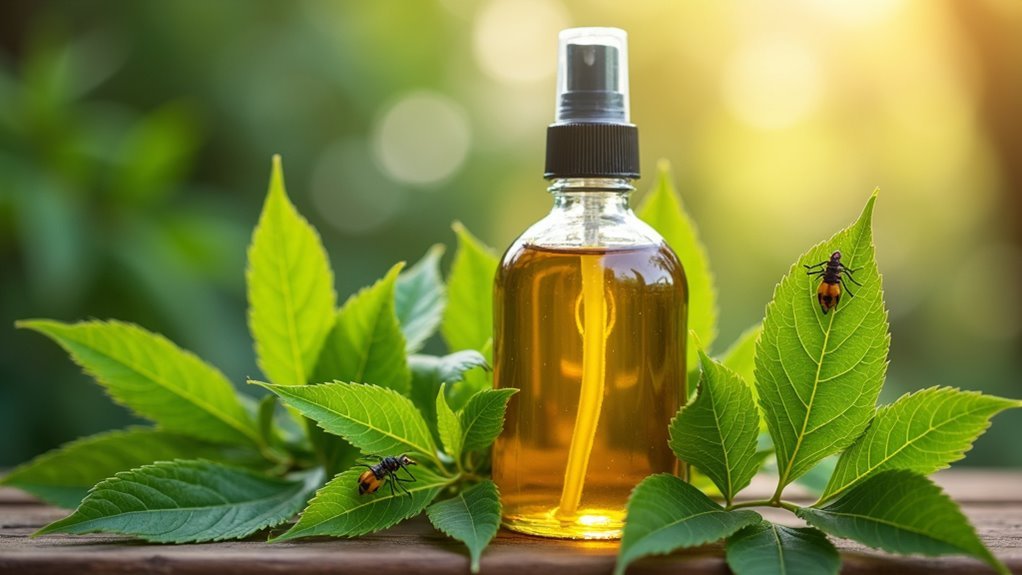
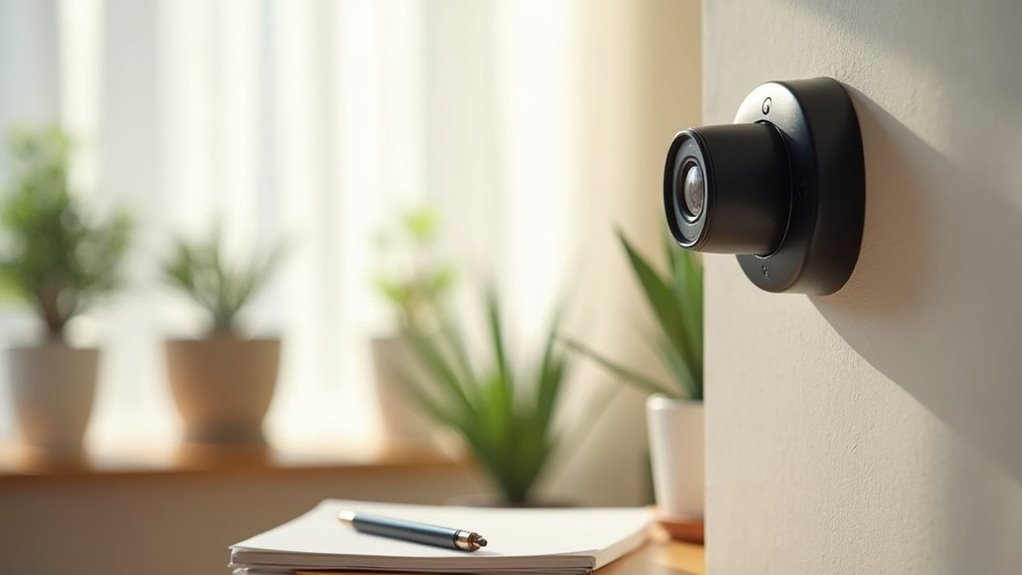

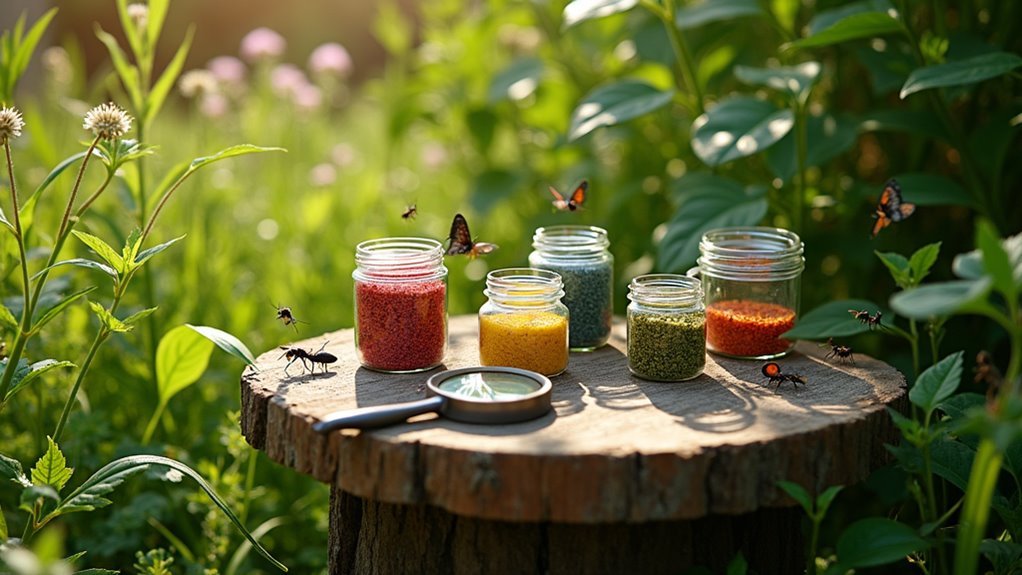
Leave a Reply